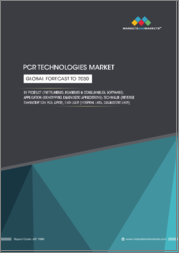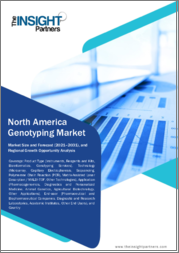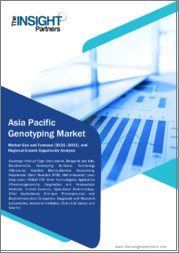
|
시장보고서
상품코드
1379109
식물 지노타이핑 장비 시장 : 세계 산업 동향, 점유율, 규모, 성장, 기회 및 예측(2023-2028년)Plant Genotyping Equipment Market: Global Industry Trends, Share, Size, Growth, Opportunity and Forecast 2023-2028 |
||||||
개요
세계 식물 지노타이핑 장비 시장 규모는 2022년 6억 8,600만 달러에 달했습니다. IMARC Group은 2028년까지 시장 규모가 12억 300만 달러에 달하고, 2022-2028년간 9.8%의 연평균 성장률(CAGR)을 나타낼 것으로 예상했습니다. 고수익 작물에 대한 수요 증가, 식물의 내성 및 적응력 향상에 대한 필요성 증가, 농업의 호황은 시장을 주도하는 주요 요인 중 일부입니다.
식물 유전형 분석은 디옥시리보핵산(DNA) 염기서열을 샘플 또는 참조와 비교 분석하여 유전적 이해의 차이를 식별하는 과정입니다. 영양가가 높고 질병과 환경 스트레스에 강한 식물을 개발하기 위해 차세대 염기서열 분석(NGS) 기술에 의존하고 있습니다. 또한 다양한 종의 다양성과 진화 연구, 생식 원종 특성화 및 종자 순도 연구, 마커 지원 선발(MAS)에도 도움이 되고 있습니다. 작물 형질 개발, 종자 품질 관리 등 다양한 농업 연구 분야에서 활용되고 있습니다. 단일염기다형성(SNP) 유전형 분석 장비, 실시간 중합효소연쇄반응(PCR) 장비, DNA 분석기, 액체 핸들러 등 다양한 장비로 구현할 수 있습니다. 식물 유전형 분석 장비는 식물의 유전자 마커를 분석, 식별 및 평가하는 데 사용됩니다. 또한, 식물의 유전자를 분자 수준에서 변화시키거나 품종 개량 과정에서 통합하여 작물 수확량을 촉진합니다.
식물 지노타이핑 장비 시장 동향 :
현재 세계 인구 증가로 인해 고수익 작물에 대한 수요가 증가하고 있습니다. 이는 농업의 번영과 함께 시장 성장을 뒷받침하는 중요한 요소 중 하나가 되었습니다. 또한, 안정적인 높은 작물 생산을 보장하기 위해 다양한 악조건에 대한 식물의 내성과 적응력을 향상시켜야 할 필요성이 증가하고 있는 것도 시장 성장을 가속하고 있습니다. 이 외에도 복잡한 식물 형질과 관련된 유전적 특성과 이러한 형질에 대한 다양한 환경 요인의 영향을 이해하기 위한 식물 유전형질 분석 장비에 대한 수요가 증가하면서 시장에 긍정적인 영향을 미치고 있습니다. 또한, 원하는 표현형 형질과 관련된 변종을 식별하기 위한 식물 유전형질 분석 장비의 사용이 세계적으로 증가하고 있습니다. 이는 현대식 농법의 도입 증가와 함께 업계 투자자들에게 유리한 성장 기회를 제공합니다. 이 외에도 수확량, 내성, 생물학적 및 생물학적 스트레스에 대한 저항성 등 식물 유전형의 거동을 이해하기 위한 식물 유전형 분석 장비에 대한 수요가 증가함에 따라 시장 성장을 강화하고 있습니다. 또한, 높은 해충 저항성, 더 많은 수확량, 향상된 스트레스 저항성과 같은 다양한 식물 특성을 향상시키기 위해 SNP 유전형질 분석 장비 및 정량적 형질 유전자좌(QTL)에 대한 수요가 증가함에 따라 좋은 시장 전망을 제공합니다.
본 보고서에서 다룬 주요 질문들
- 2022년 식물 지노타이핑 장비 세계 시장 규모는?
- 2023-2028년 세계 식물 지노타이핑 장비 시장의 예상 성장률은?
- 식물 지노타이핑 장비 세계 시장을 주도하는 주요 요인은?
- 코로나19가 세계 식물 지노타이핑 장비 시장에 미친 영향은?
- 식물 지노타이핑 장비 세계 시장에서의 장비별 분류는?
- 식물 지노타이핑 장비 세계 시장 용도별 분류는?
- 식물 지노타이핑 장비 세계 시장은 최종 용도에 따라 어떻게 구분되는가?
- 식물 지노타이핑 장비 세계 시장에서 주요 지역은?
- 식물 지노타이핑 장비 세계 시장 내 주요 기업은?
목차
제1장 서문
제2장 조사 범위와 조사 방법
- 조사 목적
- 이해관계자
- 데이터 소스
- 1차 정보
- 2차 정보
- 시장 추정
- 보텀업 접근
- 톱다운 접근
- 조사 방법
제3장 주요 요약
제4장 서론
- 개요
- 주요 산업 동향
제5장 세계의 식물 지노타이핑 장비 시장
- 시장 개요
- 시장 실적
- COVID-19의 영향
- 시장 예측
제6장 시장 분석 : 장비별
- SNP 지노타이핑 장비
- 시장 동향
- 시장 예측
- 실시간 PCR 기기
- 시장 동향
- 시장 예측
- DNA 애널라이저
- 시장 동향
- 시장 예측
- 액체 처리기
- 시장 동향
- 시장 예측
- 기타
- 시장 동향
- 시장 예측
제7장 시장 분석 : 용도별
- 식물 연구
- 시장 동향
- 시장 예측
- 육종
- 시장 동향
- 시장 예측
- 제품 개발
- 시장 동향
- 시장 예측
- 품질 평가
- 시장 동향
- 시장 예측
제8장 시장 분석 : 최종 용도별
- 온실
- 시장 동향
- 시장 예측
- 밭
- 시장 동향
- 시장 예측
- 실험실
- 시장 동향
- 시장 예측
제9장 시장 분석 : 지역별
- 북미
- 미국
- 시장 동향
- 시장 예측
- 캐나다
- 시장 동향
- 시장 예측
- 미국
- 아시아태평양
- 중국
- 시장 동향
- 시장 예측
- 일본
- 시장 동향
- 시장 예측
- 인도
- 시장 동향
- 시장 예측
- 한국
- 시장 동향
- 시장 예측
- 호주
- 시장 동향
- 시장 예측
- 인도네시아
- 시장 동향
- 시장 예측
- 기타
- 시장 동향
- 시장 예측
- 중국
- 유럽
- 독일
- 시장 동향
- 시장 예측
- 프랑스
- 시장 동향
- 시장 예측
- 영국
- 시장 동향
- 시장 예측
- 이탈리아
- 시장 동향
- 시장 예측
- 스페인
- 시장 동향
- 시장 예측
- 러시아
- 시장 동향
- 시장 예측
- 기타
- 시장 동향
- 시장 예측
- 독일
- 라틴아메리카
- 브라질
- 시장 동향
- 시장 예측
- 멕시코
- 시장 동향
- 시장 예측
- 기타
- 시장 동향
- 시장 예측
- 브라질
- 중동 및 아프리카
- 시장 동향
- 시장 내역 : 국가별
- 시장 예측
제10장 SWOT 분석
- 개요
- 강점
- 약점
- 기회
- 위협
제11장 밸류체인 분석
제12장 Porter의 Five Forces 분석
- 개요
- 바이어의 교섭력
- 공급 기업의 교섭력
- 경쟁 정도
- 신규 진출업체의 위협
- 대체품의 위협
제13장 가격 분석
제14장 경쟁 구도
- 시장 구조
- 주요 기업
- 주요 기업 개요
- Agilent Technologies Inc.
- BGI Genomics
- Eurofins Scientific
- Evogene Ltd.
- Illumina Inc.
- LGC Biosearch Technologies
- Merck KgaA
- Oxford Nanopore Technologies Limited
- PerkinElmer Inc.
- Promega Corporation
- Thermo Fisher Scientific
Abstract
The global plant genotyping equipment market size reached US$ 686 Million in 2022. Looking forward, IMARC Group expects the market to reach US$ 1,203 Million by 2028, exhibiting a growth rate (CAGR) of 9.8% during 2022-2028. The rising demand for high yielding crops, increasing need to improve the tolerance and adaptability of plants, and the thriving agriculture industry represent some of the key factors driving the market.
Plant genotyping is the process of identifying the differences in genetic comprehension by analyzing the deoxyribonucleic acid (DNA) sequence with a sample or reference. It relies on next-generation sequencing (NGS) technology to develop plants with high nutritional content and resistance to illnesses and environmental stress. It assists in studying the diversity and evolution of different species, germplasm characterization and seed purity, and marker-assisted selection (MAS). It is used in various fields of agricultural research, such as crop trait development and seed quality control. It can be achieved through various equipment, such as single nucleotide polymorphism (SNP) genotyping equipment, real-time polymerase chain reaction (PCR) instruments, DNA analyzer, and liquid handler. Plant genotyping equipment is used to analyze, identify, and assess genetic markers in the plant. It also promotes crop yield by changing or integrating the genes of plants at the molecular level and during the breeding process.
Plant Genotyping Equipment Market Trends:
At present, there is a rise in the demand for high-yielding crops due to the growing population across the globe. This, along with the thriving agriculture industry, represents one of the key factors supporting the growth of the market. Moreover, the increasing need to improve the tolerance and adaptability of plants to various adverse environments for assuring stable and higher crop production is propelling the growth of the market. Besides this, the growing demand for plant genotyping equipment to understand the genetic characteristics associated with complex plant traits and the effects of various environmental factors on these traits is positively influencing the market. In addition, there is an increase in the utilization of plant genotyping equipment to identify variants associated with desired phenotypic traits around the world. This, coupled with the rising adoption of modern farming practices, is offering lucrative growth opportunities to industry investors. Apart from this, the escalating demand for plant genotyping equipment to understand the genotype behavior of plants, such as yield, tolerance, and resistance against biotic and abiotic stress, is strengthening the growth of the market. Additionally, the growing demand for SNP genotyping equipment and quantitative trait locus (QTL) for enhancing various plant characteristics, such as high pest resistance, more yield, and improved stress tolerance, is offering a favorable market outlook.
Key Market Segmentation:
IMARC Group provides an analysis of the key trends in each segment of the global plant genotyping equipment market report, along with forecasts at the global, regional and country levels from 2023-2028. Our report has categorized the market based on equipment, application and end use.
Equipment Insights:
SNP Genotyping Equipment
Real-time PCR Instrument
DNA Analyzer
Liquid Handler
Others
The report has provided a detailed breakup and analysis of the plant genotyping equipment market based on the equipment type. This includes SNP genotyping equipment, real-time PCR instrument, DNA analyzer, liquid handler, and others. According to the report, SNP genotyping equipment represented the largest segment.
Application Insights:
Plant Research
Breeding
Product Development
Quality Assessment
A detailed breakup and analysis of the plant genotyping equipment market based on the application has also been provided in the report. This includes plant research, breeding, product development, and quality assessment. According to the report, breeding accounted for the largest market share.
End Use Insights:
Greenhouse
Field
Laboratory
A detailed breakup and analysis of the plant genotyping equipment market based on the end use has also been provided in the report. This includes greenhouse, field, and laboratory. According to the report, laboratory accounted for the largest market share.
Regional Insights:
North America
United States
Canada
Asia-Pacific
China
Japan
India
South Korea
Australia
Indonesia
Others
Europe
Germany
France
United Kingdom
Italy
Spain
Russia
Others
Latin America
Brazil
Mexico
Others
Middle East and Africa
The report has also provided a comprehensive analysis of all the major regional markets, which include North America (the United States and Canada); Asia Pacific (China, Japan, India, South Korea, Australia, Indonesia, and others); Europe (Germany, France, the United Kingdom, Italy, Spain, Russia, and others); Latin America (Brazil, Mexico, and others); and the Middle East and Africa. According to the report, Europe was the largest market for plant genotyping equipment. Some of the factors driving the Europe plant genotyping equipment market included the growing research and development (R&D) activities in agriculture, development of advanced plant genotyping equipment, increasing food security concerns, etc.
Competitive Landscape:
The report has also provided a comprehensive analysis of the competitive landscape in the global plant genotyping equipment market. Competitive analysis such as market structure, market share by key players, player positioning, top winning strategies, competitive dashboard, and company evaluation quadrant has been covered in the report. Also, detailed profiles of all major companies have been provided. Some of the companies covered include Agilent Technologies Inc., BGI Genomics, Eurofins Scientific, Evogene Ltd., Illumina Inc., LGC Biosearch Technologies, Merck KgaA, Oxford Nanopore Technologies Limited, PerkinElmer Inc., Promega Corporation, Thermo Fisher Scientific, etc. Kindly note that this only represents a partial list of companies, and the complete list has been provided in the report.
Key Questions Answered in This Report
- 1. What was the size of the global plant genotyping equipment market in 2022?
- 2. What is the expected growth rate of the global plant genotyping equipment market during 2023-2028?
- 3. What are the key factors driving the global plant genotyping equipment market?
- 4. What has been the impact of COVID-19 on the global plant genotyping equipment market?
- 5. What is the breakup of the global plant genotyping equipment market based on the equipment?
- 6. What is the breakup of the global plant genotyping equipment market based on the application?
- 7. What is the breakup of the global plant genotyping equipment market based on the end use?
- 8. What are the key regions in the global plant genotyping equipment market?
- 9. Who are the key players/companies in the global plant genotyping equipment market?
Table of Contents
1 Preface
2 Scope and Methodology
- 2.1 Objectives of the Study
- 2.2 Stakeholders
- 2.3 Data Sources
- 2.3.1 Primary Sources
- 2.3.2 Secondary Sources
- 2.4 Market Estimation
- 2.4.1 Bottom-Up Approach
- 2.4.2 Top-Down Approach
- 2.5 Forecasting Methodology
3 Executive Summary
4 Introduction
- 4.1 Overview
- 4.2 Key Industry Trends
5 Global Plant Genotyping Equipment Market
- 5.1 Market Overview
- 5.2 Market Performance
- 5.3 Impact of COVID-19
- 5.4 Market Forecast
6 Market Breakup by Equipment
- 6.1 SNP Genotyping Equipment
- 6.1.1 Market Trends
- 6.1.2 Market Forecast
- 6.2 Real-time PCR Instrument
- 6.2.1 Market Trends
- 6.2.2 Market Forecast
- 6.3 DNA Analyzer
- 6.3.1 Market Trends
- 6.3.2 Market Forecast
- 6.4 Liquid Handler
- 6.4.1 Market Trends
- 6.4.2 Market Forecast
- 6.5 Others
- 6.5.1 Market Trends
- 6.5.2 Market Forecast
7 Market Breakup by Application
- 7.1 Plant Research
- 7.1.1 Market Trends
- 7.1.2 Market Forecast
- 7.2 Breeding
- 7.2.1 Market Trends
- 7.2.2 Market Forecast
- 7.3 Product Development
- 7.3.1 Market Trends
- 7.3.2 Market Forecast
- 7.4 Quality Assessment
- 7.4.1 Market Trends
- 7.4.2 Market Forecast
8 Market Breakup by End Use
- 8.1 Greenhouse
- 8.1.1 Market Trends
- 8.1.2 Market Forecast
- 8.2 Field
- 8.2.1 Market Trends
- 8.2.2 Market Forecast
- 8.3 Laboratory
- 8.3.1 Market Trends
- 8.3.2 Market Forecast
9 Market Breakup by Region
- 9.1 North America
- 9.1.1 United States
- 9.1.1.1 Market Trends
- 9.1.1.2 Market Forecast
- 9.1.2 Canada
- 9.1.2.1 Market Trends
- 9.1.2.2 Market Forecast
- 9.1.1 United States
- 9.2 Asia-Pacific
- 9.2.1 China
- 9.2.1.1 Market Trends
- 9.2.1.2 Market Forecast
- 9.2.2 Japan
- 9.2.2.1 Market Trends
- 9.2.2.2 Market Forecast
- 9.2.3 India
- 9.2.3.1 Market Trends
- 9.2.3.2 Market Forecast
- 9.2.4 South Korea
- 9.2.4.1 Market Trends
- 9.2.4.2 Market Forecast
- 9.2.5 Australia
- 9.2.5.1 Market Trends
- 9.2.5.2 Market Forecast
- 9.2.6 Indonesia
- 9.2.6.1 Market Trends
- 9.2.6.2 Market Forecast
- 9.2.7 Others
- 9.2.7.1 Market Trends
- 9.2.7.2 Market Forecast
- 9.2.1 China
- 9.3 Europe
- 9.3.1 Germany
- 9.3.1.1 Market Trends
- 9.3.1.2 Market Forecast
- 9.3.2 France
- 9.3.2.1 Market Trends
- 9.3.2.2 Market Forecast
- 9.3.3 United Kingdom
- 9.3.3.1 Market Trends
- 9.3.3.2 Market Forecast
- 9.3.4 Italy
- 9.3.4.1 Market Trends
- 9.3.4.2 Market Forecast
- 9.3.5 Spain
- 9.3.5.1 Market Trends
- 9.3.5.2 Market Forecast
- 9.3.6 Russia
- 9.3.6.1 Market Trends
- 9.3.6.2 Market Forecast
- 9.3.7 Others
- 9.3.7.1 Market Trends
- 9.3.7.2 Market Forecast
- 9.3.1 Germany
- 9.4 Latin America
- 9.4.1 Brazil
- 9.4.1.1 Market Trends
- 9.4.1.2 Market Forecast
- 9.4.2 Mexico
- 9.4.2.1 Market Trends
- 9.4.2.2 Market Forecast
- 9.4.3 Others
- 9.4.3.1 Market Trends
- 9.4.3.2 Market Forecast
- 9.4.1 Brazil
- 9.5 Middle East and Africa
- 9.5.1 Market Trends
- 9.5.2 Market Breakup by Country
- 9.5.3 Market Forecast
10 SWOT Analysis
- 10.1 Overview
- 10.2 Strengths
- 10.3 Weaknesses
- 10.4 Opportunities
- 10.5 Threats
11 Value Chain Analysis
12 Porters Five Forces Analysis
- 12.1 Overview
- 12.2 Bargaining Power of Buyers
- 12.3 Bargaining Power of Suppliers
- 12.4 Degree of Competition
- 12.5 Threat of New Entrants
- 12.6 Threat of Substitutes
13 Price Analysis
14 Competitive Landscape
- 14.1 Market Structure
- 14.2 Key Players
- 14.3 Profiles of Key Players
- 14.3.1 Agilent Technologies Inc.
- 14.3.1.1 Company Overview
- 14.3.1.2 Product Portfolio
- 14.3.1.3 Financials
- 14.3.1.4 SWOT Analysis
- 14.3.2 BGI Genomics
- 14.3.2.1 Company Overview
- 14.3.2.2 Product Portfolio
- 14.3.2.3 Financials
- 14.3.3 Eurofins Scientific
- 14.3.3.1 Company Overview
- 14.3.3.2 Product Portfolio
- 14.3.3.3 Financials
- 14.3.3.4 SWOT Analysis
- 14.3.4 Evogene Ltd.
- 14.3.4.1 Company Overview
- 14.3.4.2 Product Portfolio
- 14.3.4.3 Financials
- 14.3.5 Illumina Inc.
- 14.3.5.1 Company Overview
- 14.3.5.2 Product Portfolio
- 14.3.5.3 Financials
- 14.3.5.4 SWOT Analysis
- 14.3.6 LGC Biosearch Technologies
- 14.3.6.1 Company Overview
- 14.3.6.2 Product Portfolio
- 14.3.7 Merck KgaA
- 14.3.7.1 Company Overview
- 14.3.7.2 Product Portfolio
- 14.3.7.3 Financials
- 14.3.7.4 SWOT Analysis
- 14.3.8 Oxford Nanopore Technologies Limited
- 14.3.8.1 Company Overview
- 14.3.8.2 Product Portfolio
- 14.3.8.3 SWOT Analysis
- 14.3.9 PerkinElmer Inc.
- 14.3.9.1 Company Overview
- 14.3.9.2 Product Portfolio
- 14.3.9.3 Financials
- 14.3.9.4 SWOT Analysis
- 14.3.10 Promega Corporation
- 14.3.10.1 Company Overview
- 14.3.10.2 Product Portfolio
- 14.3.11 Thermo Fisher Scientific
- 14.3.11.1 Company Overview
- 14.3.11.2 Product Portfolio
- 14.3.11.3 Financials
- 14.3.1 Agilent Technologies Inc.



















